
A significant new player has emerged in the fiercely competitive artificial intelligence landscape, as Inception, a startup founded by Stanford professor Stefano Ermon, announced a substantial $50 million seed funding round. This capital infusion, spearheaded by Menlo Ventures and bolstered by angel investments from AI luminaries Andrew Ng and Andrej Karpathy, positions Inception at the forefront of a burgeoning movement to apply diffusion-based AI models to the intricate domains of code and text generation. The company’s ambition is to challenge the prevailing autoregressive paradigm, promising a new generation of AI tools characterized by enhanced efficiency and speed.
The Intensifying AI Investment Frontier
The current technological era is undeniably defined by an unprecedented surge in AI innovation and investment. Billions of dollars are flowing into startups and established tech giants alike, all vying for supremacy in the development of increasingly sophisticated artificial intelligence. This funding environment, while exhilarating, also reflects a high-stakes competition where novel approaches and demonstrable performance gains are paramount. Inception’s $50 million seed round, a considerable sum for early-stage financing, underscores investor confidence not only in its leadership but also in the potential disruptive power of its core technological premise. It highlights a strategic belief that groundbreaking research, particularly when it deviates from mainstream methodologies, can carve out significant market share, even against well-entrenched competitors. The involvement of seasoned venture capital firms like Menlo Ventures, known for backing transformative technologies, alongside the personal endorsements of Ng and Karpathy—figures whose contributions have profoundly shaped modern AI—lends substantial credibility and momentum to Inception’s mission. Their participation signals a recognition of Inception’s potential to address some of the most pressing challenges facing AI development today, particularly in optimizing computational resources and improving model performance.
A Paradigm Shift in Generative AI Architecture
At the heart of Inception’s strategy lies the application of diffusion models to areas traditionally dominated by autoregressive architectures. To grasp the significance of this, it’s crucial to understand the fundamental differences between these two model types. Autoregressive models, epitomized by large language models (LLMs) like OpenAI’s GPT series, Google’s Gemini, and Anthropic’s Claude, operate sequentially. They predict the next word or token in a sequence based on all preceding tokens, effectively building outputs piece by piece. This method has proven incredibly powerful for conversational AI, content generation, and many text-based applications, allowing for fluid and contextually relevant responses.
Diffusion models, conversely, operate on a fundamentally different principle of iterative refinement. Originating from the field of probabilistic generative modeling, these models learn to reverse a process of noise addition. Imagine an image being progressively corrupted with random noise until it becomes pure static. A diffusion model is trained to reverse this process, starting from pure noise and iteratively "denoising" it until a coherent image emerges. This "denoising" happens over several steps, gradually refining the output based on learned patterns. This architectural approach has famously powered the recent explosion in image generation AI, giving rise to tools like Stable Diffusion, Midjourney, DALL-E, and more recently, video generation models like Sora, which can produce highly realistic and creative visual content from text prompts. The success of diffusion models in the visual domain has been nothing short of revolutionary, demonstrating their capability to generate complex, high-fidelity outputs through a holistic, rather than sequential, construction process.
The novel aspect of Inception’s work is extending this iterative refinement approach from images and other continuous data to the discrete and structured world of text and code. While the conventional wisdom has long favored autoregressive models for their natural fit with sequential language, a growing body of academic research suggests that diffusion models may offer distinct advantages in scenarios involving large quantities of text, complex structural dependencies, or data-constrained environments. This includes tasks such as processing extensive documents, understanding complex codebases, or generating highly structured data where overall coherence and consistency are paramount over word-by-word prediction.
The Visionary Leadership of Stefano Ermon
Leading Inception’s ambitious endeavor is Stefano Ermon, a distinguished professor at Stanford University. Ermon’s academic career has been deeply rooted in the study of diffusion models, long before they captured mainstream attention with the advent of popular image generation tools. His foresight in recognizing the potential of these models, coupled with years of dedicated research, places him in a unique position to spearhead their application to new frontiers. This background provides a crucial foundation of expertise and experience, distinguishing Inception from many other AI startups that might simply be adapting existing techniques.
The endorsement from industry titans Andrew Ng and Andrej Karpathy further solidifies Inception’s standing. Andrew Ng, co-founder of Google Brain and Coursera, and a key figure in the popularization of deep learning, has consistently championed practical, impactful AI. Andrej Karpathy, former head of AI at Tesla and a founding member of OpenAI, is renowned for his deep technical understanding of neural networks and their applications. Their angel investments are not merely financial but serve as powerful validations of Ermon’s vision and the technical viability of Inception’s approach, indicating a belief that this paradigm shift could indeed yield significant breakthroughs.
Mercury: Empowering the Software Development Lifecycle
In tandem with its funding announcement, Inception released a new iteration of its flagship product, the Mercury model. Specifically engineered for software development, Mercury aims to revolutionize how developers interact with and create code. The model has already seen integration into several specialized development tools, including ProxyAI, Buildglare, and Kilo Code, showcasing its practical applicability even at this early stage.
The software development lifecycle is ripe for AI-driven transformation. Developers frequently grapple with challenges such as writing boilerplate code, debugging complex systems, refactoring large codebases, and navigating extensive documentation. Traditional code generation tools, often built on autoregressive LLMs, can assist with these tasks, but they sometimes struggle with maintaining global coherence across large files or understanding the intricate semantic dependencies within a vast project. Ermon asserts that Mercury’s diffusion-based approach is uniquely suited to address these pain points. By generating code through iterative refinement, Mercury can potentially maintain a more holistic understanding of the codebase’s structure and intent, leading to more consistent, accurate, and contextually appropriate outputs. This could translate into significantly faster development cycles, reduced errors, and a more efficient allocation of developer resources. Imagine an AI assistant that not only completes a line of code but understands the entire function’s purpose and adapts its suggestions to fit the project’s architectural patterns.
Unlocking Unprecedented Performance and Efficiency
The most compelling advantages claimed by Inception for its diffusion models center on critical performance metrics: latency and compute cost. These are two of the most significant bottlenecks currently limiting the widespread and cost-effective deployment of sophisticated AI models, particularly LLMs, in enterprise environments. Autoregressive models, by their sequential nature, often require significant computational power for each prediction step, leading to higher latency (response time) and substantial inference costs, especially for generating long sequences.
Ermon highlights that diffusion models possess inherent structural advantages that allow for parallel processing. Unlike autoregressive models that must execute operations one after another, diffusion models can process many operations simultaneously across their iterative refinement steps. This parallelizability translates directly into significantly lower latency for complex tasks and a more efficient utilization of hardware, particularly modern GPUs. Inception has benchmarked Mercury at over 1,000 tokens per second, a speed that Ermon claims is "way higher than anything that’s possible using the existing autoregressive technologies." This speed is not just a marginal improvement; it represents a potential step-change in the responsiveness of AI systems. For developers, faster code completion, instantaneous bug fixes, and rapid refactoring suggestions could dramatically enhance productivity. For businesses, lower compute costs could democratize access to advanced AI capabilities, making sophisticated tools economically viable for a broader range of applications and users. The ability to process complex requests quickly and efficiently could also open doors to entirely new real-time AI applications that are currently constrained by the computational overhead of existing models.
Historical Context and the Future Trajectory of AI
The evolution of generative AI has been a fascinating journey, marked by continuous architectural innovations. Early AI systems often relied on rule-based logic or statistical methods. The rise of neural networks in the 1980s and 90s, followed by recurrent neural networks (RNNs) and Long Short-Term Memory (LSTM) networks, allowed AI to process sequential data like text and speech with greater proficiency. However, it was the advent of the Transformer architecture in 2017 that truly revolutionized the field, enabling the creation of powerful autoregressive LLMs capable of understanding and generating human-like text at unprecedented scales. Models like GPT-3, BERT, and their successors have profoundly impacted everything from search engines to content creation platforms.
Inception’s push for diffusion models represents a potential next wave of innovation, offering an alternative pathway to generative intelligence. While autoregressive models have excelled at prediction and completion, diffusion models could prove superior in tasks demanding holistic creation and structural integrity. This ongoing architectural exploration is a testament to the dynamic nature of AI research, where no single approach is considered definitive. The field constantly seeks new ways to overcome limitations, whether they be computational efficiency, data requirements, or the ability to handle increasingly complex and diverse data types.
Market Dynamics and Societal Implications
The market for AI models and development tools is experiencing explosive growth, with companies vying to offer foundational models, specialized applications, and infrastructure solutions. Inception enters a competitive landscape dominated by tech giants and well-funded startups. However, its focus on a distinct architectural approach, coupled with demonstrated performance advantages in efficiency and speed, could carve out a significant niche. If Inception can scale its diffusion models effectively and demonstrate sustained advantages, it could shift market expectations for AI performance in text and code generation. This could lead to a broader industry re-evaluation of optimal model architectures for various tasks, potentially fostering a more diverse and resilient AI ecosystem.
The broader social and cultural impacts of highly efficient code and text generation AI are profound. For software development, it could accelerate the pace of innovation, allowing developers to focus on higher-level problem-solving rather than repetitive coding tasks. This could lead to a surge in new applications and services, further digitizing various industries. However, it also raises questions about the future of human labor in software engineering and creative writing, requiring careful consideration of reskilling and adaptation. Furthermore, the ability to generate vast quantities of coherent and complex text and code with lower computational overhead could transform fields like scientific research, legal analysis, and creative industries, enabling unprecedented levels of content production and analysis. As with all powerful technologies, the ethical implications—concerning bias, transparency, control, and potential misuse—will remain central to the discourse surrounding their development and deployment. Inception’s efforts signify not just a technical leap, but a step towards redefining the capabilities and accessibility of advanced AI for a new generation of applications.





